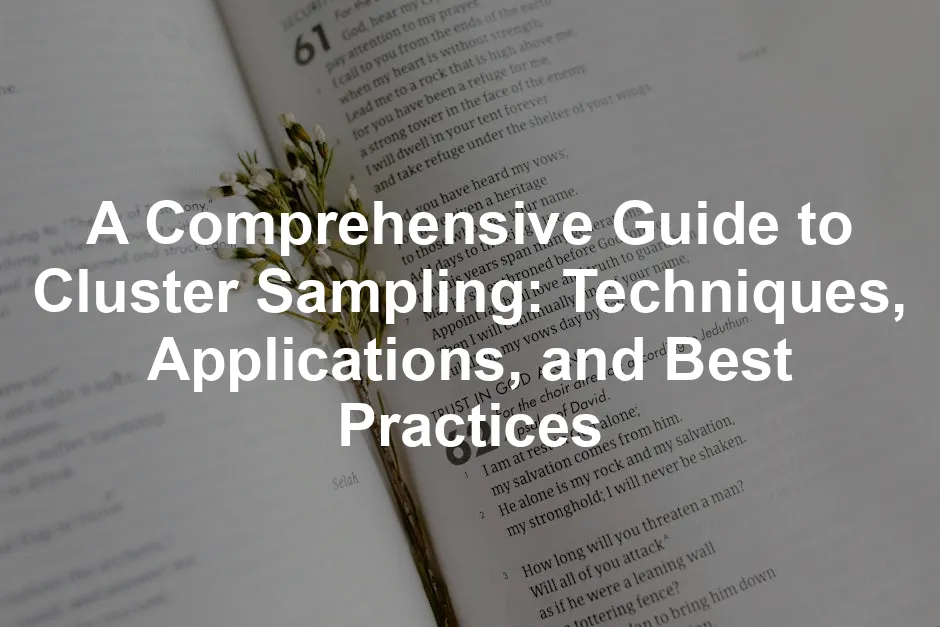Introduction
Cluster sampling is a method that groups a population into clusters. Researchers then randomly select clusters to gather data. This technique plays a vital role in statistical research, especially when studying large populations. As data collection becomes increasingly important across various fields, efficient sampling techniques like cluster sampling are essential for researchers seeking quality insights.
If you’re looking to dive deeper into the world of statistics, consider checking out Introduction to Statistics: A Step-by-Step Approach. It’s like having a personal tutor in your pocket!
Summary and Overview
Cluster sampling simplifies data collection by dividing a population into smaller, manageable groups or clusters. The primary goal is to randomly select these clusters for analysis. Unlike stratified sampling, which targets specific subgroups, cluster sampling treats entire clusters as units. Understanding this methodology is crucial for effective data collection and analysis. Its relevance extends to market research, public health studies, and educational assessments, making it a versatile tool for researchers.

For those curious about the intricacies of data modeling, The Data Warehouse Toolkit: The Definitive Guide to Dimensional Modeling is your go-to resource!
What is Cluster Sampling?
Cluster sampling is a probability sampling technique that divides a population into clusters. A cluster consists of groups of individuals with shared characteristics. Researchers randomly select some clusters and gather data from all individuals within these chosen groups. This method is particularly valuable for large population studies, where reaching every individual is impractical.
The importance of cluster sampling lies in its ability to streamline data collection. By focusing on clusters, researchers can save time and resources while still obtaining representative samples. For example, in public health studies, clusters may represent geographic areas, allowing researchers to assess health outcomes more efficiently.
Statistics show that cluster sampling is widely used in various fields, including education, marketing, and healthcare. In market research, for instance, companies often group consumers by location to gather insights on preferences and behaviors. This method enhances the reliability of data collection while maintaining a manageable scope.
Imagine conducting research without the hassle of reaching out to every single individual. Cluster sampling makes this dream a reality! If you want to learn more about research design, you might find Research Design: Qualitative, Quantitative, and Mixed Methods Approaches a fantastic read!

Types of Cluster Sampling
Single-Stage Cluster Sampling
Single-stage cluster sampling involves selecting entire clusters randomly. Researchers then gather data from every member in those chosen clusters. This method is efficient for large populations where accessing each individual is impractical. For instance, if a health organization wants to study vaccination rates, it might randomly select several neighborhoods and survey all residents within those neighborhoods. This approach simplifies data collection and reduces travel costs.
Two-Stage Cluster Sampling
Two-stage cluster sampling adds an extra layer of selection. First, researchers randomly choose clusters. Then, they select a random sample of individuals from each selected cluster. This method is advantageous when clusters vary in size, allowing for a more manageable sample. A practical example is a school district assessing student performance. The district might randomly select schools (clusters) and then randomly choose students within those schools to participate in the study.

Multi-Stage Cluster Sampling
Multi-stage cluster sampling involves multiple levels of selection. Researchers start by randomly selecting larger clusters, then subdivide those into smaller groups for further sampling. This method is particularly useful for extensive studies that span diverse areas. For example, a national survey on internet usage might begin by selecting states, then cities within those states, and finally households within those cities. This hierarchical approach helps researchers manage data collection efficiently while ensuring a representative sample.
Steps to Conduct Cluster Sampling
Step 1: Define the Population
Clearly defining the population is crucial for effective sampling. This involves identifying the specific group you want to study, whether it’s a demographic, geographic area, or another characteristic. A well-defined population ensures that the clusters formed will accurately reflect the diversity of the entire group.
Step 2: Create Clusters
Forming effective clusters requires criteria that ensure each cluster represents the overall population. Consider factors like geography, demographics, or shared characteristics. Proper clustering helps maximize the representative nature of the sample while minimizing bias in data collection.

Step 3: Random Selection of Clusters
To ensure a fair study, use random selection methods to choose clusters. This can involve techniques like simple random sampling or systematic sampling. Random selection minimizes the risk of bias, offering a better chance that the chosen clusters will accurately represent the larger population.
Step 4: Data Collection
Data collection within clusters can be accomplished through various methods. Surveys are a popular choice, allowing researchers to gather information directly from individuals in selected clusters. Interviews, either face-to-face or via phone, can also yield in-depth insights. In some cases, observational methods may be employed to gather data without disturbing the subjects. The key is to ensure that the chosen method aligns with the research objectives while maximizing response rates and data quality.

Step 5: Data Analysis
Analyzing data from cluster samples involves specific techniques tailored to this sampling method. Researchers often use statistical software to handle the unique structure of cluster data. Techniques like analysis of variance (ANOVA) can help identify differences between clusters. Additionally, regression analysis may be employed to understand relationships within the data. It’s crucial to account for the clustering effect during analysis to ensure accurate results and valid conclusions.
Advantages of Cluster Sampling
Cluster sampling offers several key benefits, making it an appealing choice for researchers. First, it is cost-effective, significantly reducing expenses associated with data collection. By targeting specific clusters, researchers minimize travel and administrative costs, making studies more affordable. In fact, cluster sampling can save up to 50% compared to traditional methods.

Moreover, this technique simplifies logistics. Instead of scattering resources across a large area, researchers can focus efforts on selected clusters, enhancing efficiency. This is especially beneficial in public health research, where evaluating community health behaviors can be accomplished more efficiently.
Another advantage lies in the natural groupings that clusters provide. These groupings often mirror real-world connections among subjects, leading to more insightful data. This method enhances data accuracy, especially when clusters are representative of the broader population.
If you’re keen on enhancing your statistical methods, consider reading The Elements of Statistical Learning: Data Mining, Inference, and Prediction. It’s a profound resource for anyone serious about data science!
In summary, cluster sampling is particularly beneficial when dealing with geographically dispersed populations or limited resources. If you’re considering a research project, evaluate the potential advantages of cluster sampling to see if it aligns with your needs.
To gain a deeper understanding of the statistical methods that can complement cluster sampling, explore this guide on statistical techniques in business and economics.
Disadvantages of Cluster Sampling
While cluster sampling offers efficiency, it comes with notable drawbacks. One major concern is the risk of bias. If clusters are not chosen randomly or are homogenous, the sample may not accurately represent the broader population. This can lead to misleading results and conclusions.

Another challenge is the potential for higher sampling errors. Since entire clusters are selected, variability within them can inflate error rates. This means researchers might miss out on critical insights that come from diverse individual responses.
To mitigate these disadvantages, careful planning is essential. Researchers should ensure clusters are diverse and representative of the population. Random selection methods can also help reduce bias. Additionally, combining cluster sampling with other methods, like stratified sampling, may improve accuracy. By addressing these issues upfront, you can maximize the benefits of cluster sampling while minimizing its downsides.
For those who want to delve into practical statistics, Practical Statistics for Data Scientists: 50 Essential Concepts is a must-read!
Applications of Cluster Sampling
Cluster sampling has diverse applications across various fields. In market research, it helps companies gather insights from specific geographical regions. For example, a brand might survey customers in randomly selected cities to assess preferences and satisfaction levels effectively.

Public health assessments often utilize cluster sampling as well. During health surveys, clusters may represent communities or neighborhoods, enabling researchers to evaluate health behaviors and needs efficiently. Recent studies have shown that this method can significantly reduce costs while providing critical data.
Educational research is another area where cluster sampling shines. By selecting schools as clusters, researchers can evaluate student performance and program effectiveness. This approach allows for comprehensive assessments while managing resources effectively. As you consider your next research project, think about how cluster sampling can enhance your data collection strategies.
And while you’re at it, why not enhance your home experience with the Amazon Echo Dot? It’s a smart speaker that can make your life easier while you conduct your research!
For those interested in understanding data analysis techniques that can complement cluster sampling, check out this article on data analysis techniques for economics and statistics students.
Conclusion
Cluster sampling is a crucial method in research. It simplifies the data collection process by allowing researchers to focus on specific groups within a larger population. This approach enhances efficiency and accuracy, particularly when studying large and diverse groups. By selecting entire clusters, researchers can gather representative data while minimizing time and costs. If you’re working on a research project, consider cluster sampling as a valuable tool. It can help you achieve your objectives more effectively while ensuring data integrity. Explore this method to see how it can meet your specific research needs.

And speaking of tools, if you love cooking or need a quick meal solution, you should definitely check out the Instant Pot Duo 7-in-1 Electric Pressure Cooker. It’s a game changer!
FAQs
What is cluster sampling and when should it be used?
Cluster sampling is a technique where a population is divided into groups, or clusters. Researchers randomly select some clusters to gather data. This method is ideal for large populations, especially when it’s impractical to sample everyone. For example, a study on school performance might use clusters of schools to simplify data collection.
How does cluster sampling differ from stratified sampling?
The main difference lies in how samples are chosen. In cluster sampling, entire clusters are selected randomly, and all members within those clusters are surveyed. In contrast, stratified sampling involves dividing the population into distinct subgroups and then sampling individuals from each subgroup. Each method serves specific research needs based on the study’s goals.
What are the advantages of using cluster sampling?
Cluster sampling offers several benefits. It is cost-effective, reduces travel expenses, and simplifies logistics. This method is efficient, especially when populations are dispersed. Additionally, it can provide representative samples if clusters are well-defined, ensuring reliable data for analysis.
Can cluster sampling introduce bias?
Yes, cluster sampling can introduce bias if clusters are not representative of the entire population. To mitigate this risk, researchers should ensure that clusters reflect the diversity of the population. Random selection methods can help maintain representativeness and reduce potential biases.
What are some common applications of cluster sampling?
Cluster sampling is widely used in various fields. In public health, it helps assess community health needs efficiently. Educational researchers often use it to evaluate school programs. Market researchers utilize it to gather consumer insights from specific geographic areas, making it a versatile tool for many studies.
What challenges might researchers face using cluster sampling?
Researchers may encounter challenges such as selecting appropriate clusters that truly represent the population. There can also be difficulties ensuring randomness in cluster selection. Additionally, analyzing data from clusters can be complex, requiring careful planning to avoid errors.
How can I ensure my cluster sampling is effective?
To ensure effective cluster sampling, clearly define your population and create representative clusters. Use random selection methods for choosing clusters and ensure diverse representation within them. Moreover, consider the size of your clusters and apply statistical techniques to account for clustering effects during analysis.
Please let us know what you think about our content by leaving a comment down below!
Thank you for reading till here 🙂
All images from Pexels




